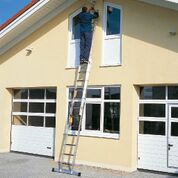
 |
Mark Sennett
Managing Editor |
 |
Kelly Rose
Editor |
| Home> | Slips, Trips & Falls | >Fall Prevention | >Staying ahead of the game |
| Home> | Slips, Trips & Falls | >Fall Protection | >Staying ahead of the game |
Staying ahead of the game
07 July 2017
Zarges has provided tips on the right approach to ladders according to the new ladder standard EN 131-1 and 2.

According to the Health and Safety Executive (HSE), there are approximately 622,000 cases of reportable work-related accidences occur in the UK each year. Such accidents often involve ladders. The European Committee for Standardisation therefore recently published the standards EN 131-1 and 2. The guidelines describe new design and test requirements. As of January 2018, ladders used in commercial operations fulfil all criteria for structural stability and load capacity. As a manufacturer, ZARGES is early on emphasising safety and informing construction and industrial companies about the implications of EN 131. The access technology specialist is already offering ladders that comply with the new standards.
As new regulations and guidelines are released, companies must understand how the changes will affect them. In the context of the standards EN 131-1 and 2, this can be summarised as follows: the new standard will include a “Professional” category that will replace BS 2037 Class 1, the current standard for industrial and heavy-duty ladders, in addition all leaning ladders that are three metres or longer will have to be equipped with a base stabiliser to ensure stability. Along with stricter test requirements in terms of stile strength and slip-resistance, EN 131-2 also sets out additional regulations for mechanical durability tests and torsion tests. Other guidelines concern the use of combination ladders as well as the categorisation of access systems. The new regulation will take effect as of 1 January 2018 in the UK and throughout Europe and will affect companies of all industries and sizes.
What is going happen in 2018?
Ladders are ubiquitous in industry and skilled trades and the new standard is intended to reduce the number of accidents and fatalities in the workplace. However, EN 131 does not expressly prohibit the continued use of ladders that are already in use. Commercial users in the UK and Europe, such as companies, skilled workers or public authorities, are merely asked to adhere to the respective workplace regulations. "Companies are currently in somewhat of a grey area. On the one hand, even though EN 131-1 and 2 have already been adopted, ladders made according to the old standard are still allowed to be sold in the UK until October 2020 at the latest, according to BSI Assurance" explains Rainer Üblacker, Head of R&D at ZARGES. "Companies that now invest in new ladders would effectively have to retrofit their existing ladders or buy new ones in the near future. On the other hand, the guidelines are not clearly defined. This creates uncertainty." In order to avoid this and offer customers security in the future, ZARGES is already able to offer ladders and stepladder that conform to the new standards.
Recognising demand – avoiding dangers – capitalising on opportunities
A binding regulation that does not make implementation compulsory is confusing for many companies. ZARGES therefore is putting more emphasis on transparency. This is because not all ladders need to be replaced within the scope of the new EU standard. Ladders that are state-of-the-art can continue to be used in the future. In order to identify these models and consequently create financial security, companies should ask their safety officer to perform a risk assessment as soon as possible. The officer must decide whether existing ladders may continue to be used. "Whoever wants to be on the safe side in the long term should try to consistently take account of the guidelines laid down by the lawmakers. It does not cost as much time and money as one might fear," explains Üblacker. He recommends that all systems be tested for weak points as part of the mandatory annual ladder inspection and regularly modified as necessary.
Infobox: Top tips on the right approach to ladders according to EN 131-1 and 2
Regularly inspect ladders: it is recommended that ladders that are subject to frequent use should be inspected at least once every three months. Take note of the inspector's qualification: An inspection is considered legally compliant only when it is performed by a certified in-house safety officer or a trained employee of a specialist company. Perform retrofitting: Access systems can be retrofitted to comply with regulations. For example, a base stabiliser can be added to a leaning ladder in accordance with EN 131-1. Safety first: In addition to annual inspections, companies should always keep an eye on the safety of their ladders and access systems. Specialist companies and manufacturers, such as ZARGES, offer relevant instructions and information.


























